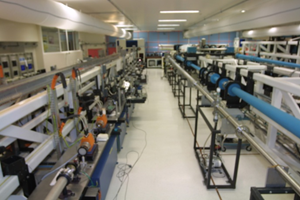Access Facilities - LULI, Palaiseau, France
 |
Contact: Access LULI Email |
A research centre and national infrastructure dedicated to laser-matter interaction and its applications, LULI is operating two multi-beam laser facilities and associate experimental areas: LULI2000 and APOLLON. LULI2000 is providing unique opportunities to couple high-energy (up to the kJ) IR light pulses to high-power (up to 200TW) ones and to external pulsed high-amplitude magnetic fields. The conducted experiments are based on laser irradiation of solid or gaseous targets to produce high-energy density matter. The versatility of the facility allows covering many fields of research, from fundamental - magnetized or not - plasma physics to inertial fusion sciences, laboratory astrophysics, planetology or material sciences. Laser-based secondary sources of high-energy particles and radiation are commonly used for innovative diagnostic techniques or for warm dense matter production. These sources will be further investigated and pushed to the extreme on APOLLON, allowing novel applications to be demonstrated. Thanks to short focal length focusing optics (f/2.5), brilliant proton, ion (including neutron) and keV-MeV radiation secondary sources will be generated at intensities up to 1022 W/cm2 while, at longer focal lengths (f/75), electrons will be accelerated up to multi-GeVs. Laser R&D programs are pursued in the lab to support continuous improvements of the current facilities, to prepare the next generation of high-energy laser systems, especially at higher repetition rates, or to design innovative metrology techniques.

Excellence: LULI’s expertise in high-energy high-power laser technologies, particle & radiation secondary sources and radiation-induced high-energy-density plasma physics is internationally well-known, applications of this later for laboratory astrophysics and planetology, warm dense matter or fusion sciences being more especially highlighted in the past decade. The high quality of the more recent research in high-field physics, including the development of the SMILEI open-source PIC code, is also recognized.
Publications:
- Laser-driven shock waves studied by x-ray radiography, L. Antonelli et al., Phys. Rev. E 95, 063205 (2017)
- High-contrast 10fs OPCPA-based front-end for multi-PW laser chains, D. Papadopoulos et al., Optics Lett. 42, 3530 (2017)
- Laboratory unravelling of matter accretion in young stars, G. Revet et al., Science Advances 3, e1700982 (2017)
- First demonstration of multi-MeV proton acceleration from a cryogenic H ribbon target, S. Kraft et al., Plasma Phys. Control. Fusion 60, 044010 (2018)
- Transition from nonlocal electron transport to radiative regime in an expanding blast wave, A. Marocchino et al., Appl. Phys. Lett. 112, 264104 (2018)

